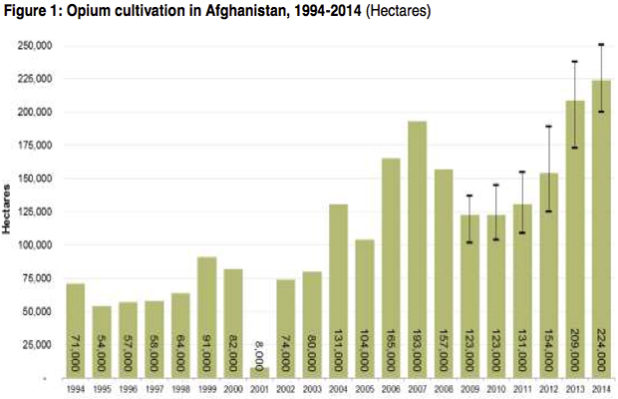The Real Afghanistan Surge is in Heroin Production and Tripled Opium Cultivation since the US military arrived/ UN and US Government documents
The US now has 600,000 heroin users, triple the amount of five years earlier, according to the Drug Enforcement Agency. Or it may instead have between 800,000 and 2.6 million, according to RAND report estimates published by the White House in 2014.
Marijuana used to be claimed the “entry” drug to heroin, but now prescription narcotics have assumed that role. How times change.
The narrative that has been presented to us implies that massively increased heroin use has nothing to do with increased supply. (This violates the laws of arithmetic and economics, not to mention common sense.) In Europe, West Asia and Russia, everyone knows their rising numbers of addicts reflects a huge increase in available heroin. But the media obscure that fact, here.
While prescriptions for narcotics (hydrocodone and oxycodone) increased 4.5-fold between 1991 and 2007 in the US, prescriptions for ADHD stimulants rose even more, by 7-fold, according to National Institute on Drug Abuse testimony to Congress in 2008:
But in fact, the DOJ-DEA 2014 National Drug Threat Assessment Summary notes that cocaine availability “remains stable at historically low levels throughout most domestic markets along the East Coast.” A RAND Report noted, “From 2006 to 2010, the amount of cocaine consumed in the United States
declined by about 50 percent — an unprecedented change over five years.” There has been a parallel decline in methamphetamine use.
So prescription drug users are switching to heroin, but not switching to cocaine. Might this be because we have no large military-CIA presence currently in cocaine-trafficking areas, as we did during the 1980s Contra war in Nicaragua, when cocaine use was at high levels? (Coca plants are only grown in South America‘s Andes.) According to a 2010 UN document, “Based on seizure figures, it appears that cocaine markets grew most dramatically during the 1980s, when the amounts seized increased by more than 40% per year”. (See this 1987 Senate hearing and this for evidence of CIA and State Dept. connivance with cocaine trafficking by the Contras.)
The graph below is from the 2014 UN Opium Survey:

“The narcotics trade poisons the Afghan financial sector and undermines the Afghan state’s legitimacy by stoking corruption, sustaining criminal networks, and providing significant financial support to the Taliban and other insurgent groups,” John F. Sopko, the Special Inspector General for Afghanistan reconstruction, said in an October 2014 letter to the heads of the Departments of Defense, State and Justice, which have all played major roles in the failed drug intervention effort. “Despite spending over $7 billion to combat opium poppy cultivation and to develop the Afghan government’s counter-narcotics capacity, opium poppy cultivation levels in Afghanistan hit an all-time high in 2013.”
The Special Inspector General noted elsewhere that, “US reconstruction projects, particularly those devoted to “improved irrigation, roads, and agricultural assistance” were probably leading to the explosion in opium cultivation.“
Serious measures are needed. Total world production of opiates always gets consumed: historically, the market for opiates has been extremely elastic. Land under poppy cultivation (in Afghanistan, Southeast Asia’s Golden Triangle and Mexico) continues to increase. Without meaningful efforts to reduce opium production and entry of narcotics into the US, the epidemic of heroin addiction could become a considerably bigger problem than it is today.
UPDATE: From the Sept 7 Wall Street Journal, we learn that a US “friendly fire” airstrike in southern Afghanistan on Sept 6 “hit a 30 member elite counternarcotics police unit as they were on a mission…”
At least 11 died in “one of the deadliest friendly fire incidents in the country in recent years.” Here is the Reuters story. The US denied the strike in Helmand province, but admitted to airstrikes in the adjacent province of Kandahar. According to the Guardian, “The US is the only member of the NATO coalition known to have carried out bombing raids in Afghanistan this year.” The AP/WaPo on 9/8/15 reported that, “Brigadier General Shoffner [Deputy Chief of Staff for Communications in Afghanistan] said ‘based on information we received [on 9/8], we feel it is prudent to investigate the airstrike our forces conducted in Kandahar.’“
The airstrike killed approximately as many people as died in counternarcotics efforts in all Afghanistan throughout 2014.
UPDATE: Helmand is the major opium-producing province in Afghanistan; military efforts in Helmand are managed primarily by the UK. In 2010, the magazine The Week accused UK soldiers of importing heroin back to Europe and Canada in military planes.
Since I wrote this piece, the US’s top General in Afghanistan, John Campbell, told Congress we need a five year plan for US and NATO involvement in Afghanistan. What precisely are we doing there? What does CIA do there? Why has the US military been prevented from stopping opium production in territories it controls? Does an even worse Afghan heroin epidemic in Russia affect US strategic thinking? What did Hillary Clinton know and do about rising Afghan heroin production during her time as Secretary of State? Why aren’t these questions being asked of our Presidential candidates?
Let me credit Professor Alfred McCoy’s work, which provided me historical background: he is probably the world’s foremost scholar on the subject of the global production and trade in illicit drugs.
